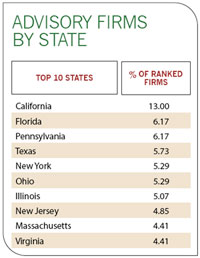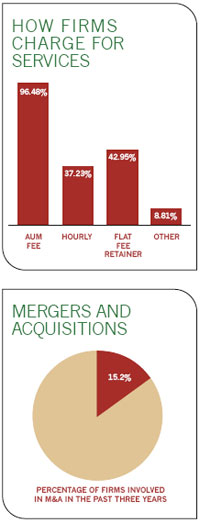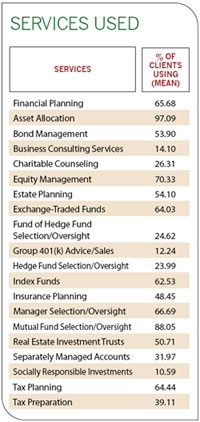There's a famous Saturday Night Live sketch in which Tom Hanks, having hosted the show five times, gets to enter a special group called the "Five Timer's Club." Privileges include use of a spa alongside other members Steve Martin, Paul Simon and Elliott Gould and drinks delivered by Jon Lovitz. Ralph Nader, a one-timer, is not allowed in.
There's another club that several RIAs often dream of belonging to-the club of firms with a billion dollars in assets. It's an arbitrary figure that might not be realistic or even prudent for many independent advisories, yet it's still the gold standard many would judge themselves by when they're dreaming big.
Of the 454 firms that participated in Financial Advisor's 2011 RIA survey, a total of 91 firms have now reached this lofty height, and 17 of those firms are new entrants. In 2005, the year the survey was inaugurated, the number was about 21.
And yet for many advisors, the goal looked farther away than ever in 2008. Not only did assets plunge, but staff was pared back and revenues for reinvesting in the business fell. It must have felt as if someone had put sugar in their gas tanks.
2010, however, was in many ways an interregnum year. Assets continued to bounce back from the financial collapse of 2008, but investors are still wary of returning to the stock market, and that hurts performance, which in turn hurts fees and revenues.
Dealing with fewer assets has been a challenge for advisors trying to build. In 2009, many firms, even those in the billion-dollar club, were still paring back staff. And remember-that was a good year in the market.
This year, however, firms have been putting people back to work. The average number of total employees rose to 17.6 from 16.2, an 8.64% increase. And staff grew at every level, from support people to management.
Client rolls have also been increasing. The average number of client relationships grew to 513 as of December 31, 2010, from 458 on the same date in 2009, an increase of 12.01%.
Assets per client have been rising as well. The median rose to $1,146,033 for 2010 from $1,079,823 for 2009, an increase of 6.13%. (The mean for 2010 was $3,009,693 versus $2,698,088 in 2009, an increase of 11.55%; those higher numbers likely show the influence of those giant outliers leading from the top of the roster.)
Some 372 firms, or 82%, saw assets per client grow, though 70 firms saw them fall.
Assets under management for all the firms in the survey rose 19.80%. The S&P 500, by contrast, rose 12.8% for the year. Only 19 of the 454 firms said they saw assets stay the same or shrink last year. Some 55 firms, or 12% of the total (not counting those that started up) said they saw their assets increase by 50% or more. Meanwhile, almost three-quarters of the firms said they saw their number of clients grow; 20 of those saw client numbers increase by 50% or more and eight firms saw client levels double.
But building clients and assets is not as easy as it looks. Competitive pressures and revenue challenges mean advisors often hit ceilings when they're trying to grow.
"The opportunities to be competitive for a $100 million firm is very tight," especially in cities, says Peter J. Raimondi, the president of Banyan Partners LLC in Palm Beach Gardens, Fla., a firm that has been acquiring advisory businesses in cities like Boston and New York and has clients in California and Pennsylvania as well.
As RIAs clawed their way back from a rough couple of years, they are going to have to find new ways to stay ahead of the game. In the age of Bernie Madoff (and Suze Orman) when clients have become savvier and more skeptical of their financial advisors, the challenge is to figure out new ways of selling yourself if you want to grow.
Clients are not just taking their friends' recommendations anymore, says Stephen Onofrio, a managing director with the SEI Advisor Network. "They've already been scarred by that and it's made an indelible mark," he says. That means the growth methods of the past have become stale, he says. "With the new consumer, you have to reinvent yourself and reinvent the ways you attract new clients. The way they did business before and attracted business before isn't the same way so they have to get more innovative and more creative and that's clearly a trend we see this year."
One firm that saw massive growth was Massey, Quick & Co. LLC in Morristown, N.J., which saw its assets balloon to $2.987 billion from $1.416 billion at the end of 2009. Stewart Massey, a founding partner, says that the firm's game is not to grow its number of clients so much as it is to selectively go after bigger fish clients, and if that's the case, then the strategy paid off in spades in 2010. Indeed, the firm grew mainly by adding a few large clients-its roster rose to only 126 from 105, but its assets per client grew by 75%.
"We're not trying to grow the number of clients as much as reaching for much larger clients," Massey says. "I think that our model is-and our plan is-to continue to try to increase the average client size. It takes just around the same amount of time to service a $100 million client as a $10 million client."
Joseph Duran, the CEO of United Capital Financial Advisers in Newport Beach, Calif., says his firm grew to 7,500 clients from 4,000 in 2010 and grew to $4.127 billion in assets under management from $1.682 billion the year before, a growth rate of 145%. United Capital has been on an acquisition tear for the past few years, making strategic purchases geographically, and looking specifically for firms that will adopt its client relationship management strategy. The firm uses a card system (called "Honest Conversations,") in which clients use sorting cards to determine goals and fears about money.
The firm's United Capital purchases adopt this system in its client meetings, and this client relationship system is part of its brand. (When asked if it sounds a bit like Jenny Craig, Duran doesn't totally disagree with the comparison.) The firm has not only been growing through its core acquisitions, Duran says, but through the new assets client bring in after they've adopted the new system.
"When we acquire a firm, they're mostly investment-centered," he says, "And we will show them how to develop clients' holistic needs and look at their entire financial life. When that happens, the client will inevitably increase the amount of assets-an average 20% increase. If a firm with half a billion joins, within 12 months they've added about 20% in new assets from increasing the client base," he says.
One of the newer firms on the list is Delphi Private Advisors, a San Diego firm founded in November 2009 which has garnered some $130 million in assets since starting up. The firm's three partners launched it after leaving Sanford Bernstein.
Bernstein "was a great place to learn the business," says co-founder Marc Channick, "but all three of us had independently come to the decision that we wanted to work in a more independent framework and over time figured out we had a similar philosophy about how we wanted to work with clients and the natural inclination was to open up our own firm."







He says many of the clients who came with them are loyal and pleased with the performance and service and used to fees for service. These clients and the group's extended professional circle have referred much new business.
"They've made a number of referrals to the professional community here in San Diego and throughout the area-a lot of attorneys and accountants. It's exclusively by referrals, so it's the clients or other professionals. Those relationships have paid off given the discomfort with what's going on in the business."
He says the firm set itself up to resemble a mix of an institutional consultancy and a family office for clients with $2 million to $25 million in liquid assets. "I think when you're a family with $100 million, $200 million or $500 million you usually have that separation between product and advice through a consultancy or family office," he says. "We took that framework and brought it down to a population that we think is primarily serviced by the big banks and brokerages, where there really is a product-oriented basis to the relationships-whereas we are obviously completely focused on advice. So we think that's a great niche for us."
Another relative newcomer to the list is Banyan, which launched in 2008 after its founder, Peter J. Raimondi, decided to pursue a boutique investment management strategy and focus less on financial planning. To become more of a national asset management firm, it has been acquiring other managers. In early 2009, at the bottom of the market, the firm acquired Oaktree Asset Management in New York, and in January 1 of this year it doubled its size with two more firms, Colonial Wealth Management in Boston and Weiss Capital Management, a firm down the street in Palm Beach Garden offices.
"2010 was for us-though for a lot of people it wasn't-a continuation of '09," says Raimondi. "It was a confirmation and continuation, and it allowed you to finally for the first time begin to make some plans to add staff or upgrade your office or do the kinds of things that had been on hold for a couple of years because of revenues declining. We made our acquisition of Oaktree literally at the bottom of the market, that was January 1 of '09. We had two more months of decline and that was it. But the firm had been fully transitioned into Banyan by the middle of '09 and now Banyan was focused for the rest of '09 and all of 2010 in building the kind of firm it wanted to, being confident we were in a rising revenue trend."
"I want to say it's 100% investment management driven, except that we do have a couple of dozen high-end wealth management clients that we do tax and estate planning work for," he says. The firm builds portfolios with small-, mid- and large-cap stocks, growth and value, etc., and also adds an options trading component so that it can create hedge-fund type products in-house.
Greg Miller, the CEO and CIO of Wellesley Investment Advisors in Wellesley, Mass., has carved out a business sub-advising for other RIAs as a manager of convertible bond portfolios. "We manage convertible portfolios for our own private clients, something we've been doing for 20 years. But we also manage money on behalf of other investment professionals who wish to offer an absolute return seeking-strategy to their clients. Since the crash of 2008, many investment professionals have seen the advantages of deploying an outside investment manager with an expertise in managing convertible bonds in an absolute return-seeking strategy."
Wellesley's convertible strategy has the goal of outperforming both equities and fixed income over complete market cycles, he says.
Indeed, outsourcing to specialists might be the wave of the future, suggests SEI's Onofrio. He says that SEI's outsourcing platform saw a 60% increase in users from 2009 to 2010. Onofrio says that one of the heaviest blows the financial crisis dealt to fee-only advisors was that it reduced their revenues at the same time fixed costs were rising. That's meant more advisors are looking at their variable costs.
"If they didn't outsource, then they had a squeeze in profitability," Onofrio says. And at the same time they've been trying to regrow their businesses off this low water mark-but at a time when the clients themselves have changed. "They ran into a much more sophisticated and educated consumer."
Those firms that still want to grow are going to have to more actively seek clients, he says, and must offer a more complete value proposition: tax planning and estate planning and comprehensive retirement. Also they will be able to outsource and automate functions like rebalancing, which is still a huge pile of busywork that drains time.
Onofrio also says that RIAs are often not so good in the client acquisition department, and it's the lack of a regular client acquisition process that keeps firms from getting out of the $100 million to $200 million rut. That's a big deal, he says, since all the money coming off the sidelines now is likely going to gravitate toward the bigger firms, and the smaller firms will continue to struggle.
"If they don't have a client acquisition process in place and it's just by chance and it's not regular-when you say intermittent or a passive process-yeah, they're going to hit a wall," he says. "It's those advisors who look at client acquisitions as an investment in their business, those are the ones that get the best return on that investment, and they have to think of it that way. It's not an expense; it's not a cost."